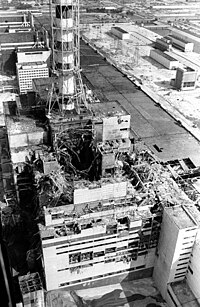
Photo from wikipedia
Abstract Objectives: This follow-up study set out to evaluate the natural course and radiographic progression of silicosis among ceramic workers and describe the risk factors related with disease progression. Materials… Click to show full abstract
Abstract Objectives: This follow-up study set out to evaluate the natural course and radiographic progression of silicosis among ceramic workers and describe the risk factors related with disease progression. Materials and methods: We retrospectively analyzed the data of ceramic workers with silicosis who were referred to our hospital between February 2010 and March 2018. A total of 165 ceramic workers followed at least 24 months and with at least two chest radiographs were included in the study. Results: The duration of silica exposure ranged from 5.5 to 27 (median 13.6) years. The numbers of patients according to follow-up time were as follows: 38 (2–2.9) years, 77 (3–3.9) years, 26 (4–4.9) years, 17 (5–5.9) years, and 7 (≥6) years. Overall 62 of 165 (37.5%) cases showed radiologic evidences of progression ranging from 2 to 8.9 years (mean 3.7 years). Pulmonary function loss rate among silicosis patients was 36.9% (61/165). Multiple logistic regression analysis showed a significant relation between radiographic progression and age (OR, 1.079: 95% CI, 1.011–1.152), follow-up time (OR, 1.557: 95% CI, 1.144–2.118), and the ILO category (category 2 or 3) at first visit (OR, 3.507: 95% CI, 1.505–8.170). Conclusions: Our findings suggest that one-third of Turkish ceramic workers with silicosis who were followed up to 8.9 years showed progression that was related to increasing age greater ILO category at time of initial visit and follow-up duration.
Journal Title: Inhalation Toxicology
Year Published: 2019
Link to full text (if available)
Share on Social Media: Sign Up to like & get
recommendations!